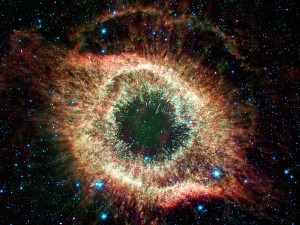
The Helix nebula as seen by NASA's Spitzer Telescope. Click image for top ten Spitzer images at Nat'l Geo
NASA has released the top ten images taken by the Spitzer telescope, and the same instrument has observed light across 41 light-years from a exo-planetary super-earth for the first time:
(MSNBC) — The planet 55 Cancri e was first discovered in 2004 and is not a habitable world. Instead, it is known as a super-Earth because of its size: The world is about twice the width of Earth and has about eight times the mass of Earth. Scientists have never been able to detect the infrared light from a super-Earth — until now.”
Spitzer has amazed us yet again,” Spitzer program scientist Bill Danch of NASA Headquarters in Washington said in a statement Tuesday. “The spacecraft is pioneering the study of atmospheres of distant planets and paving the way for NASA’s upcoming James Webb Space Telescope to apply a similar technique on potentially habitable planets.”
Spitzer first detected infrared light from an alien planet in 2005. But that world was “hot Jupiter,” a gas giant planet much larger than 55 Cancri e that orbited extremely close to its parent star. Other telescopes have performed similar feats since then, but Spitzer’s view of the 55 Cancri e is the first time the light from a rocky super-Earth type planet has been seen, researchers said.

Gorgeous.
It grieves me that much of physics (especially particle physics) has not been very exciting the last 20 years. But cosmology and astronomy have taken my breath away.
Cheers.
55 cancris e sure is a weird planet, twice Earth’s size , eight times Earth’s mass with a “year” under a singel earthday at just 18 hours as it scrapes agianst its star.
So much about it unknown yet so much amazingly discovered already for such a small fiant speck next to a stellar spotlight.
I love this stuff.
And if folsk want to gpo outside and spot teh srat round whcih yonder exopanet whirls see:
http://stars.astro.illinois.edu/sow/55cnc.html
for photographic finderchart.
PS. The star marked there as Asellus Australis (Delta Cancris) also rejoices in the longest starname of all :
Arkushanangarushashutu
Which is an ancient Bablyonian positional starname meaning “the southeast star in the Crab” in that ancient tongue.*
That’s an orange giant star just one side of Messier 44 a.k.a. Praesepe or the Beehive open star cluster.
* source : Allen, Richard Hinckley, ‘Star Names; Their Lore and Meaning’, Dover, 1963.
D’oh, the typos in comment #1 -sorry folks, too overtired as usual. Make that :
And if folks want to go outside and spot the star round which yonder exopanet whirls ..
Oh-So-Lovely. And I can’t help loving the inadvertent Chevrolet logo in #4!
D Heddle, that you?
DarkSyde,
I hope so, I’m wearing his underwear.